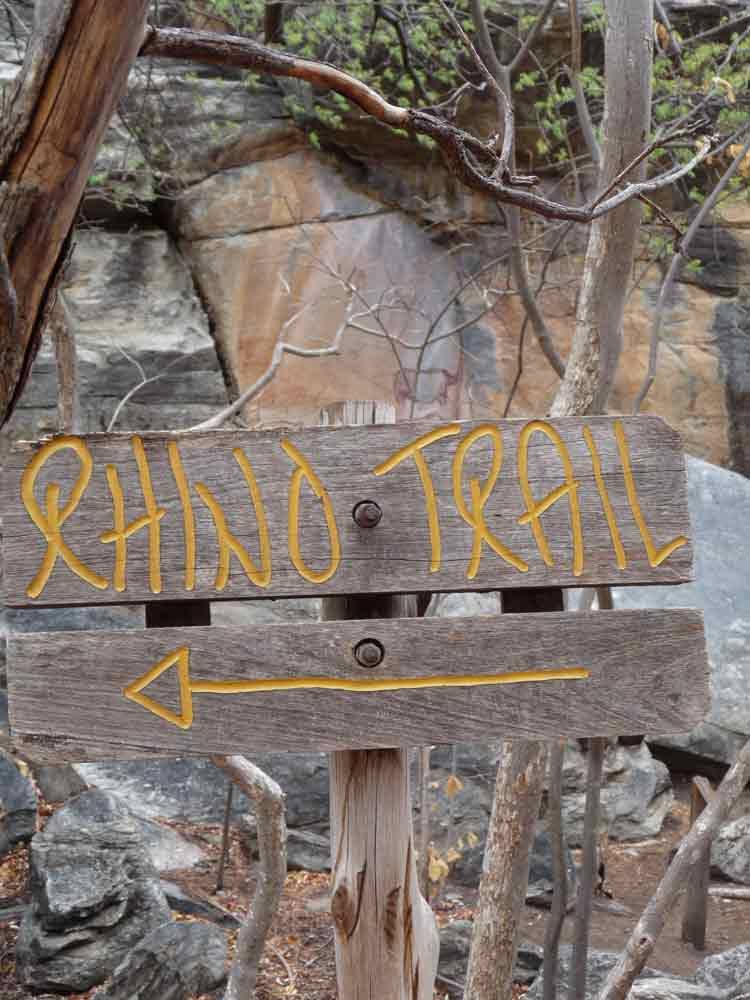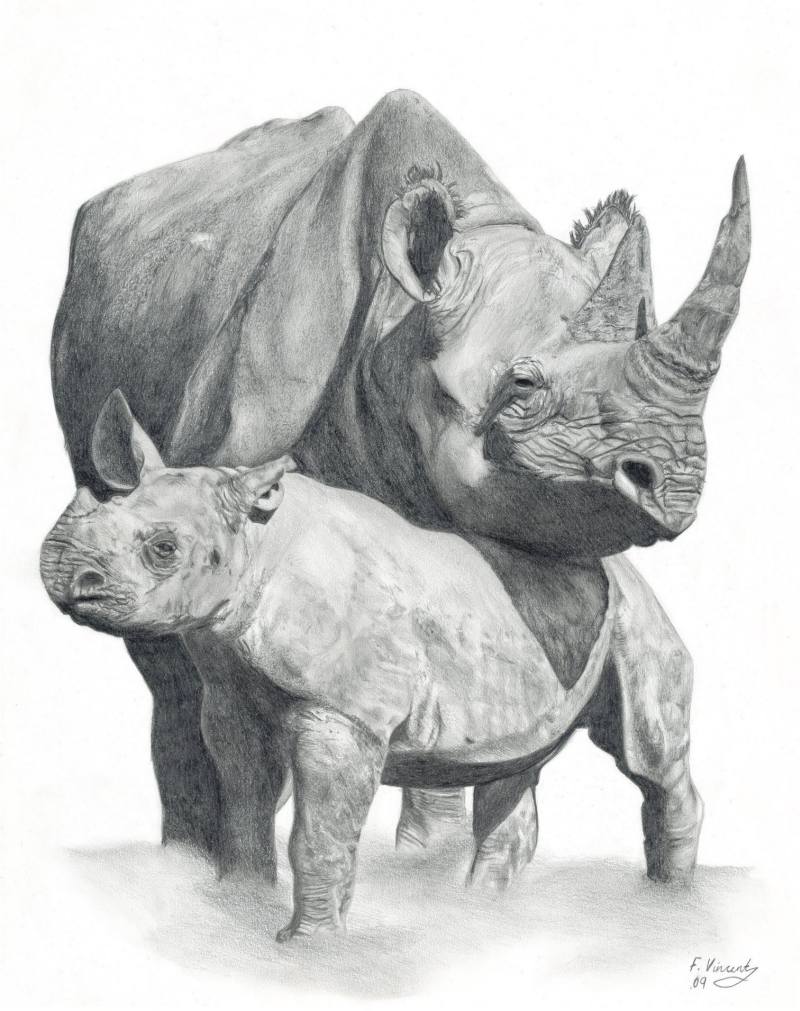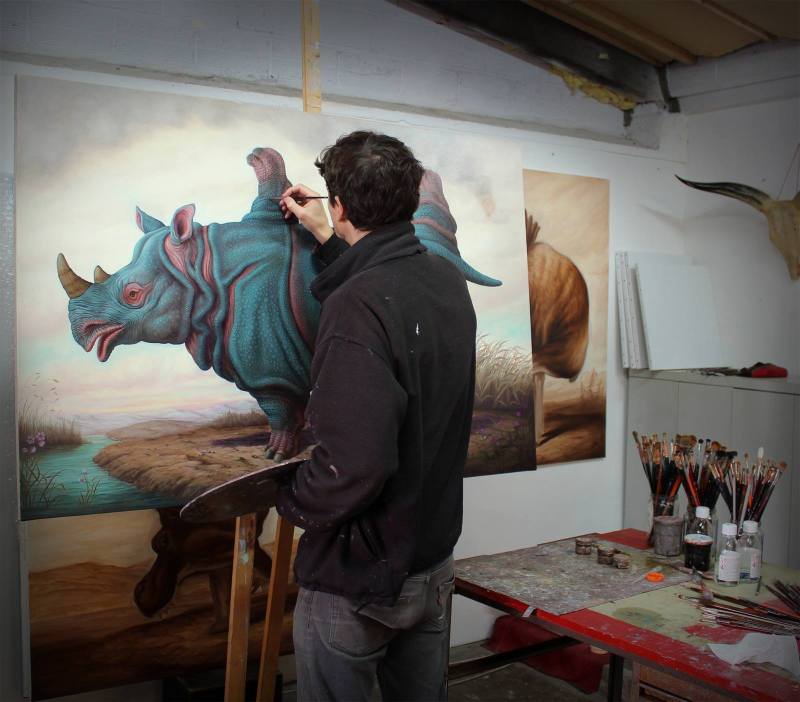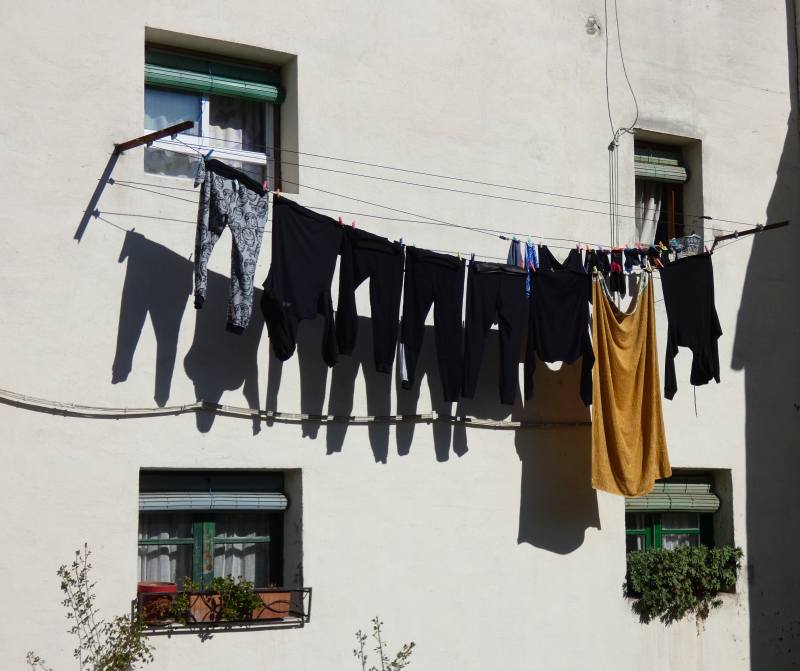Retomamos las recopilaciones rinocerónticas en el blog. Para la oportunidad, algunas curiosas antigüedades y una variopinta selección de material pinctórico para seguir engordando el acerbo del blog. Que lo disfruten.
We resume the rhinocerontic compilations in the blog. For the opportunity, some curious antiques and a motley selection of pictorial material to continue fattening the blog's collection. Enjoy.
____________________________________________________
Tsodilo Hills
Colinas de Tsodilo / Tsodilo Hills. Foto / Photo: Joachim Huber. Wikimedia Commons
Los rinocerontes que dan nombre al sendero / The rhinos after which the Rhino Trail is named
Foto / Photo: Surfing Africa
Tsodilo Hills (Las colinas de Tsodilo) es un conjunto de cuatro colinas (Macho, Hembra, Niño y Nieto) que Balson definió en 1953 como "El Louvre del desierto". El sitio se encuentra en el desierto del Kalahari, en noroeste de Bostwana, al oeste del Delta del Okavango, no muy lejos de la frontera de Namibia, y fue inluido en 2001 por la UNESCO en la lista de Patrimonio de la Humanidad, debido a las más de 4500 pinturas que se concentran en sus aproximadamente 10 km2.
Las pinturas son una muestra de las manifestaciones espirituales y religiosas de las distintas civilizaciones que han poblado estas tierras durante milenios. La mayoría se encuentra en la colina Hembra. Las más famosas son las llamadas Ballena, Dos rinocerontes y León. Algunas tienen casi 24.000 años de antigüedad.
Si bien algunas están dispersas y en lugares de difícil acceso, los visitantes pueden recorrer el "Sendero del rinoceronte" (Rhino Trail), que resulta ser el más accesible y completo.
Hay varios ejemplos de pinturas de rinocerontes. Les dejo algunos ejemplos.
Foto / Photo: Turismo de naturaleza
Sendero del rinoceronte / Rhino Trail
Tsodilo Hills (Tsodilo Hills) is a group of four hills (Male, Female, Child and Grandchild) that Balson defined in 1953 as "The Louvre of the desert". The site is located in the Kalahari Desert, in northwestern Botswana, west of the Okavango Delta, not far from the Namibian border, and was included in 2001 by UNESCO in the list of World Heritage Sites, due to the more than 4500 paintings that are concentrated in its approximately 10 km2.
The paintings are a sample of the spiritual and religious manifestations of the different civilizations that have populated these lands for millennia. Most of them are located in the Female hill. The most famous are the ones called Whale, Two Rhinoceroses and Lion. Some are almost 24,000 years old.
While some are scattered and in places that are difficult to access, visitors can hike the Rhino Trail, which happens to be the most accessible and complete.
There are several examples of rhino paintings. Here are a few examples.
Foto / Photo: The Road Chose Me
Foto / Photo: Surfing Africa
Fuentes / Sources:
* "Tras los espíritus de Tsodilo Hills". Turismo de naturaleza
_________________________________________________________________
Tassili N'Ajjer
Rinoceronte grabado en roca. Región de Tadrart / Rock engraving of a Rhino. Tadrart region.
Foto / Photo: Peter Boekamp
Tassili n'Ajjer ("Meseta del toro" en idioma tamahaq) es un parque nacional en el desierto del Sahara, ubicado en una vasta meseta en el sureste de Argelia. Posee una de las agrupaciones de arte rupestre prehistórico más importantes del mundo y cubre un área de más de 72000 kilómetros cuadrados. Fue inscrito en la lista de sitios considerados Patrimonio Mundial de la UNESCO en 1982.
Tassili n'Ajjer ("Bull Plateau" in Tamahaq language) is a National Park in the Sahara Desert, located on a vast plateau in southeastern Algeria. It has one of the most important prehistoric rock art groupings in the world and covers an area of over 27800 mi². It was inscribed on UNESCO's list of World Heritage Sites in 1982.
_________________________________________________________________
Arte rupestre San / San Rock Art
Drakensberg
Los montes Drakensberg ("Montañas del Dragón" en afrikáans) son las montañas más altas de Sudáfrica, elevándose en Thabana Ntlenyana hasta los 3482 m de altura. En isiZulu, el idioma de los zulúes, se llaman uKhahlamba, la "barrera de las lanzas". En Lesoto se les conoce como Maloti.
Están situadas en la parte oriental de Sudáfrica, corriendo aproximadamente por 1000 kilómetros generalmente del sudoeste hacia el nordeste, con una curva en el noroeste que forma la frontera noreste de Lesoto con Sudáfrica. De la cordillera surgen al oeste el río Orange y el río Vaal, y en el este y sur varios ríos más pequeños, el río Tugela sería el más grande. La cordillera separa la provincia KwaZulu-Natal de la provincia del Estado Libre, asomando sobre la cercana costa de Natal.
El sur de África es conocido por sus animales salvajes, sus culturas únicas y sus impresionantes paisajes. Sin embargo, también es conocido por su arte rupestre San (Bosquimano). Por sus antiguos dibujos San escondidos en cuevas y montañas. Curioso arte rupestre que representa la vida cotidiana, la caza, los rituales, las creencias espirituales y la vida salvaje. Estos dibujos ofrecen una instantánea de lo que vivían las tribus hace miles de años, mucho antes (y después) de la llegada de los primeros europeos.
Una pintura rupestre descubierta en la cueva de Blombos es el ejemplo más antiguo de arte humano conocido, que data de hace unos 73.000 años.
Las técnicas de datación arqueológica han mejorado mucho con los años. Por ello, hoy hemos confirmado que parte del arte rupestre hallado en Sudáfrica, en el Parque uKhahlamba Drakensberg (Patrimonio de la Humanidad), tiene unos 3 000 años de antigüedad. La estimación inicial era de unos 1000 años.
Arte San, pintura rupestre de rinocerontes / San Art, Rhinos Rock Painting. Foto / Photo: Kated
The Drakensberg Mountains ("Dragon Mountains" in Afrikaans) are the highest mountains in South Africa, rising at Thabana Ntlenyana to 11,880 ft. In isiZulu, the language of the Zulu, they are called uKhahlamba, the "barrier of spears". In Lesotho they are known as Maloti.
They are located in the eastern part of South Africa, running for approximately 1000 kilometers generally from southwest to northeast, with a bend in the northwest forming Lesotho's northeastern border with South Africa. The Orange River and the Vaal River emerge from the range in the west, and several smaller rivers in the east and south, the Tugela River being the largest. The mountain range separates the KwaZulu-Natal province from the Free State province, looming over the nearby Natal coast.
Southern Africa is best known for its wild animals, unique cultures and breathtaking landscapes. It is, however, also renowned for its San rock art. For its ancient San drawings hidden away in caves and mountains. Curious rock art that depicts daily life, hunting, rituals, spiritual beliefs and wildlife. These drawings offer a snapshot of what the tribes experienced thousands of years ago - long before (and after) the first Europeans arrived.
A rock painting discovered at Blombos Cave is the oldest known instance of human art, dating to around 73,000 years ago.
Archaeological dating techniques have improved a lot over the years. Today we have therefore confirmed that some rock art found in South Africa, at the uKhahlamba Drakensberg Park (a World Heritage Site), is about 3 000 years old. That compared to the initial estimate of about 1 000 years.
Fuentes / Sources:
Thaba Sione
Rinoceronte blanco picoteado y figura humana/terioide en el extremo izquierdo /
Pecked white rhinoceros and human/therianthrope figure on the far left.
2013,2034.18595 © TARA/David Coulson. British Museum
Thaba Sione, un yacimiento de grabados rupestres inusualmente complejos en la provincia del Noroeste de Sudáfrica, se interpreta como un importante centro religioso san.
Rinoceronte negro con cuernos alargados a la izquierda y cuernos truncados a la derecha con grieta en la pared de la roca por encima /
Black rhinoceros with elongated horns on the left and truncated horns on the right with crack in rock face above.
2013,2034.18583 © TARA/David Coulson. British Museum
Thaba Sione, a site of unusually complex rock engravings in the North West province of South Africa, is interpreted as an important San religious centre.
Damaraland, Twyfelfontein
Twyfelfontein (en afrikáans: manantial incierto), conocido oficialmente como ǀUi-ǁAis (Damara/Nama: pozo de agua saltarín), es un sitio de antiguos grabados en roca en la región de Kunene, en el noroeste de Namibia. Consiste en un manantial situado en un valle flanqueado por las laderas de una montaña de piedra arenisca que recibe muy pocas precipitaciones y tiene una amplia gama de temperaturas diurnas.
El lugar ha estado habitado desde hace 6.000 años, primero por cazadores-recolectores y después por pastores khoikhoi. Ambos grupos étnicos lo utilizaban como lugar de culto y para realizar rituales chamánicos. En el proceso de estos rituales se crearon al menos 2.500 tallas en la roca, así como algunas pinturas rupestres. Con una de las mayores concentraciones de petroglifos en roca de África, la UNESCO aprobó Twyfelfontein como el primer sitio del Patrimonio Mundial de Namibia en 2007. Wikipedia
Rinoceronte picado en un bloque / Block- pecked rhinoceros. Twyfelfontein, Namibia. 2013,2034.20476 © TARA/David Coulson. British Museum
Twyfelfontein (Afrikaans: uncertain spring), officially known as ǀUi-ǁAis (Damara/Nama: jumping waterhole), is a site of ancient rock engravings in the Kunene Region of north-western Namibia. It consists of a spring in a valley flanked by the slopes of a sandstone table mountain that receives very little rainfall and has a wide range of diurnal temperatures.
The site has been inhabited for 6,000 years, first by hunter-gatherers and later by Khoikhoi herders. Both ethnic groups used it as a place of worship and a site to conduct shamanist rituals. In the process of these rituals at least 2,500 items of rock carvings have been created, as well as a few rock paintings. Displaying one of the largest concentrations of rock petroglyphs in Africa, UNESCO approved Twyfelfontein as Namibia's first World Heritage Site in 2007. Wikipedia
_________________________________________________________________
Ouarzazate
Arte rupestre grabado de un rinoceronte y una forma ovalada, de Ait Ouazik, valle del Draa, provincia de Ouazarzate, Marruecos /
Engraved rock art of a rhinoceros and an oval shape, from Ait Ouazik, Draa valley, Ouazarzate province, Morocco. 2013,2034.5277 © TARA/David Coulson. British Museum
_________________________________________________________________
Azulejos de Delft / Delft Tiles
Algunos ejemplos de azulejos holandeses, fabricados en Delft en el s.XVII, en los que aparecen rinocerontes.
Azulejo de cerámica / Ceramic Tile, 13 x 13 cm., c.1630. Foto / Photo: Regts
Some examples of Dutch tiles, made in Delft in the 17th century, showing rhinos.
Izq./ Left: Azulejo de cerámica / Ceramic Tile, ± 1660. Foto / Photo: Antiques Delft
Der./ Right: Azulejo de cerámica / Ceramic Tile, 13 x 13 cm., 1680. Foto / Photo: Rhino Resource Center
Azulejo de cerámica / Ceramic Tile, 13 x 13 cm., 1650. Foto / Photo: Rhino Resource Center
_________________________________________________________________
Redmer Hoekstra
(Zwolle, Nederland / Países Bajos / Netherlands, 1982-)
2020
Redmer Hoekstra es un artista holandés sobre cuya obra hemos tratado ya un par de veces en el blog: primero en un post monográfico en 2015, y más adelante incorporando algunos de sus dibujos con rinocerontes a la serie. Aquí un par más, de su producción reciente.
2020
Redmer Hoekstra is a Dutch artist whose work we have already discussed a couple of times on the blog: first in a monographic post in 2015, and later incorporating some of his rhino drawings into the series. Here are a couple more, from his recent output.
Redmer Hoekstra en "El Hurgador" / in this blog: [Redmer Hoekstra (Dibujo)], [Rinocerontes (LXIV)], [Recolección (CLXXIV-2)]
Jane Lee McCracken
(Edimburgo, Escocia / Edinburgh, Scotland)
"Rinoceronte / Rhino", dibujo a bolígrafo / Biro drawing, 2014. Link
Después de terminar el crucigrama, la abuela de Jane solía dibujar para ella elegantes mujeres en los márgenes del periódico, utilizando un bolígrafo. Esto inspiró a Jane a utilizar la birome como su medio de dibujo preferido y, finalmente, a crear imágenes a partir de sus experiencias infantiles.
Recibir postales de lugares exóticos que su padre visitaba debido a su trabajo y leer sobre los animales que veía, contribuyó a la fascinación de Jane por la vida salvaje. Todo ello inspiró su interés por la guerra y la pérdida, la naturaleza, el cine y los viajes, y puede verse reflejado en su obra.
Jane trabaja como artista a tiempo completo desde 2006. La sencillez de coger una birome y dibujar complejas obras de arte no sólo sobre el papel, sino también sobre objetos, es algo que Jane encuentra tan liberador como desafiante.
"Rinoceronte / Rhino" (detalle / detail)
After finishing the crossword Jane’s Grandmother would often draw elegant women in the margins of the newspaper for her, using a ballpoint pen. This inspired Jane to use Biro as her preferred drawing medium and ultimately create images from her childhood experiences.
Receiving postcards from exotic places her father visited through his work and reading about the animals he saw, contributed to Jane’s fascination for wildlife. All of these were inspirational to her interests in war and loss, nature, film and travel and can be seen reflected in her work.
Jane has worked as a full time artist since 2006. The simplicity of picking up a Biro and drawing complex works of art not only on paper, but also on objects, is something Jane finds both liberating and challenging.
"Rinoceronte / Rhino" (detalle / detail)
_________________________________________________________________
Frances Ruth Vincent
(Ipswich, Suffolk, Reino Unido / UK, 1991-)
Desde que Frances era una niña ha disfrutado capturando el mundo que la rodea a través del arte. Frances es una artista autodidacta y lleva exponiendo su obra en muestras y exposiciones locales desde los 12 años.
El trabajo de Frances es más que un dibujo fino... quiere capturar la energía del sujeto, y dice que el proceso de dibujo es tan importante como la pieza terminada. Cada trazo de lápiz ha sido cuidadosamente colocada para crear una imagen con la que ella quiere que el espectador conecte. No se trata sólo de dibujar bien, sino de aprender a crear vida en el dibujo.
Ever since Frances was a child she has enjoyed capturing the world around her through art. Frances is a self taught artist and has been exhibiting her work in local shows and exhibitions since she was 12 years old.
Frances' work is more than fine drawing… she wants to capture the energy of the subject, and says that the drawing process is just as important as the finished piece. Every pencil mark has been carefully placed to create an image that she wants the viewer to connect with. It’s not just about drawing well, its about learning to create life in the drawing.
_________________________________________________________________
Bruno Pontiroli
(Francia / France, 1981-)
Bruno trabajando en / at work with "Le cloche patte". Instagram
Más rinocerontes distorsionados del artista francés Bruno Pontiroli, que también ha visitado el blog en un par de oportunidades con sus notables creaciones llenas de humor e ingenio.
"Le cloche patte", óleo sobre lino / oil on linen, 97 x 146 cm., 2018. Instagram
"Le Profil Bas / El perfil bajo / The Low Profile"
Óleo sobre lienzo / oil on canvas, 55 x 46 cm., 2018. Instagram
More distorted rhinoceroses by French artist Bruno Pontiroli, who has also visited the blog a couple of times with his remarkable creations full of humor and wit.
Imagen / Image: Juxtapoz
Bruno Pontiroli en "El Hurgador" / in this blog: [Bruno Pontiroli (Pintura)], [Rinocerontes (XCII)]
_________________________________________________________________
Austen Pinkerton
(North Harrow, Londres, Reino Unido / London, UK, 1951-)
"Cabeza de rinoceronte / Rhino Head", pastel sobre papel / pastel on paper, 16,5" x 12". Saatchi
Austen Pinkerton se educó localmente en la Pinner County Grammar School. Al salir de Pinner County se matriculó en la Escuela de Arquitectura de Oxford, en el Politécnico de Oxford, donde estudió los dos primeros años de la carrera (siete años). Al final del segundo año se le sugirió que considerara el traslado a la Escuela de Arte, a raíz de los cuadros que incluyó en una exposición final del segundo año.
Después de pasar un año como portero de hospital en Harrow, comenzó a estudiar en el Goldsmiths College, Universidad de Londres, Escuela de Arte, graduándose en 1976 con una licenciatura en Bellas Artes (Pintura). Tras dejar el Goldsmiths, volvió a la arquitectura para ganarse la vida. Posteriormente, trabajó durante unos 30 años a tiempo parcial para diversas empresas de arquitectura y diseño de interiores, mientras seguía pintando, dibujando y haciendo esculturas.
Entre 1990 y 1996 abrió y dirigió una galería en East Dulwich, al sur de Londres, "The Austen Pinkerton Gallery", en la que sólo exponía su propia obra.
Hasta agosto de 2007 trabajó a tiempo parcial como ayudante del arquitecto Richard Lincoln y del diseñador de interiores Chester Jones en reformas de propiedades residenciales de alto nivel en el centro de Londres.
Como resultado del colapso de la industria de la construcción en 2008, creó su propio negocio en asociación con el fotógrafo Stephen Street como constructor general/manitas, mientras seguía trabajando como artista una media de dos días a la semana.
"Cabeza de rinoceronte / Rhino Head"
Austen Pinkerton was educated locally at Pinner County Grammar School. On leaving Pinner County he enrolled at the Oxford School of Architecture, Oxford Polytechnic, where he studied for the first two years of the course (seven years). At the end of the second year it was suggested that he should consider transferring to Art College, as a result of pictures he included in a second year final exhibition.
After a year spent as a hospital porter in Harrow, he began study at Goldsmiths College, London University, School of Art, graduating in 1976 with a Batchelor of Arts: Fine Art (Painting). After leaving Goldsmiths he returned to architecture in order to earn a living. He subsequently worked for about 30 years part-time for a variety of Architectural and Interior Design firms, whilst continuing to Paint, Draw, and make Sculptures.
Between 1990 and 1996 he opened and ran a gallery in East Dulwich, south London, ..'The Austen Pinkerton Gallery' , showing only his own work.
Up until August 2007 he worked part time as assistant to the architect Richard Lincoln and also the Interior Designer Chester Jones on refurbishments of 'High End Residential' properties in central London.
As a result of the collapse in the construction industry in 2008 he set up his own business in partnership with the photographer Stephen Street as a general builder/handyman, whilst continuing to work as an artist on average two days a week.
_________________________________________________________________
Martin Klein
(Bischofswerda, Sachsen, Deutschland / Sajonia, Alemania /
Saxony, Germany, 1979-)
"Nashorn Wippe / Balancín de rinoceronte / Rhino Seesaw"
Acrílico y monos de plástico / acrylic and plastic monkeys. Kunst & Ambiente
El joven pintor y escultor Martin Klein nació en 1979 y es de Sajonia. Klein pasó su infancia en un sólido hogar paterno en la ciudad sajona de Bischofswerda. Como hijo de un artesano, Klein descubrió el placer de trabajar con sus propias manos a una edad temprana. Al mismo tiempo, Klein desarrolló un gran interés por el arte. Su padre reconoció este interés y lo fomentó. Para Klein, la escultura y la pintura son la combinación perfecta de arte y artesanía. Esto se refleja claramente en sus obras.
The young painter and sculptor Martin Klein was born in 1979 and comes from Saxony. Klein spent his childhood in a solid parental home in the Saxon town of Bischofswerda. As the son of a craftsman, Klein discovered early on the joy of working with his own hands. At the same time, Klein developed a great interest in art. His father recognized this interest and encouraged it. For Klein, sculpture and painting are the perfect combination of art and craft. This is clearly reflected in his works.
"Nashorn Wippe / Balancín de rinoceronte / Rhino Seesaw" (detalle / detail)
Un rinoceronte supera la gravedad. Se encuentra sobre un balancín que sólo es sostenido por una multitud de monos, que dan la impresión de no poder oponerse a este peso. Pero en el arte todo es posible y así el rinoceronte se mantiene en la cima y se balancea elegantemente sobre el balancín. Este motivo desconcertante incitará sin duda al espectador a echar un segundo vistazo. Sólo entonces se darán cuenta de la naturaleza especial de este cuadro. Los monos no están pintados. Son pequeños monos de plástico que se han pegado en el lienzo. La mezcla de materiales y el carácter de collage hacen de este cuadro una obra de arte extraordinaria, incluso al margen del fascinante motivo.
"Nashorn Wippe / Balancín de rinoceronte / Rhino Seesaw" (detalle / detail)
A rhinoceros overcomes gravity. It stands on a seesaw that is only held up by a gaggle of monkeys, which gives the impression that it can't counteract this weight. But in art everything is possible and so the rhinoceros stays on top and balances elegantly over the seesaw. This disconcerting motif certainly prompts the viewer to take a second look. With this he will only recognize the peculiarity of this picture. The monkeys are not painted. They are small monkeys made of plastic, which were glued to the canvas. The mix of materials and the collage character make this painting an extraordinary work of art even apart from the fascinating motif.
Más sobre / More about Martin Klein: facebook, Kunst & Ambiente






















































